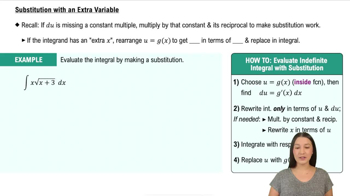Why can the constant of integration be omitted from the antiderivative when evaluating a definite integral?
Table of contents
- 0. Functions7h 54m
- Introduction to Functions16m
- Piecewise Functions10m
- Properties of Functions9m
- Common Functions1h 8m
- Transformations5m
- Combining Functions27m
- Exponent rules32m
- Exponential Functions28m
- Logarithmic Functions24m
- Properties of Logarithms36m
- Exponential & Logarithmic Equations35m
- Introduction to Trigonometric Functions38m
- Graphs of Trigonometric Functions44m
- Trigonometric Identities47m
- Inverse Trigonometric Functions48m
- 1. Limits and Continuity2h 2m
- 2. Intro to Derivatives1h 33m
- 3. Techniques of Differentiation3h 18m
- 4. Applications of Derivatives2h 38m
- 5. Graphical Applications of Derivatives6h 2m
- 6. Derivatives of Inverse, Exponential, & Logarithmic Functions2h 37m
- 7. Antiderivatives & Indefinite Integrals1h 26m
- 8. Definite Integrals4h 44m
- 9. Graphical Applications of Integrals2h 27m
- 10. Physics Applications of Integrals 3h 16m
- 11. Integrals of Inverse, Exponential, & Logarithmic Functions2h 34m
- 12. Techniques of Integration7h 41m
- 13. Intro to Differential Equations2h 55m
- 14. Sequences & Series5h 36m
- 15. Power Series2h 19m
- 16. Parametric Equations & Polar Coordinates7h 58m
8. Definite Integrals
Introduction to Definite Integrals
Problem 5.2.55b
Textbook Question
Properties of integrals Consider two functions ƒ and g on [1,6] such that ∫₁⁶ƒ(𝓍) d𝓍 = 10 and ∫₁⁶g(𝓍) d𝓍 = 5, ∫₄⁶ƒ(𝓍) d𝓍 = 5 , and ∫₁⁴g(𝓍) d𝓍 = 2. Evaluate the following integrals.
(b) ∫₁⁶ (f(𝓍) ― g(𝓍)) d𝓍
 Verified step by step guidance
Verified step by step guidance1
Step 1: Recall the property of integrals that states ∫ₐᵇ (ƒ(𝓍) ± g(𝓍)) d𝓍 = ∫ₐᵇ ƒ(𝓍) d𝓍 ± ∫ₐᵇ g(𝓍) d𝓍. This allows us to split the integral into two separate integrals.
Step 2: Apply the property to the given integral ∫₁⁶ (ƒ(𝓍) ― g(𝓍)) d𝓍. This becomes ∫₁⁶ ƒ(𝓍) d𝓍 ― ∫₁⁶ g(𝓍) d𝓍.
Step 3: Substitute the given values for the integrals: ∫₁⁶ ƒ(𝓍) d𝓍 = 10 and ∫₁⁶ g(𝓍) d𝓍 = 5.
Step 4: Perform the subtraction operation symbolically: 10 ― 5.
Step 5: The result of the subtraction gives the value of the integral ∫₁⁶ (ƒ(𝓍) ― g(𝓍)) d𝓍. This completes the evaluation process.
 Verified video answer for a similar problem:
Verified video answer for a similar problem:This video solution was recommended by our tutors as helpful for the problem above
Video duration:
1mPlay a video:
Was this helpful?
Key Concepts
Here are the essential concepts you must grasp in order to answer the question correctly.
Properties of Definite Integrals
Definite integrals have several key properties, including linearity, which states that the integral of a sum of functions is the sum of their integrals. This means that for any two functions f and g, ∫(f + g) dx = ∫f dx + ∫g dx. Additionally, the integral of a constant multiplied by a function can be factored out: ∫k * f dx = k * ∫f dx. Understanding these properties is essential for evaluating integrals involving combinations of functions.
Recommended video:

Definition of the Definite Integral
Fundamental Theorem of Calculus
The Fundamental Theorem of Calculus connects differentiation and integration, stating that if F is an antiderivative of f on an interval [a, b], then ∫ₐᵇ f(x) dx = F(b) - F(a). This theorem allows us to evaluate definite integrals by finding the antiderivative of the integrand. It is crucial for solving problems involving definite integrals, as it provides a method to compute the area under a curve.
Recommended video:

Fundamental Theorem of Calculus Part 1
Substitution in Integrals
Substitution is a technique used in integration to simplify the process of finding integrals. It involves changing the variable of integration to make the integral easier to evaluate. For example, if we let u = g(x), then the integral ∫f(g(x))g'(x)dx can be transformed into ∫f(u)du. This method is particularly useful when dealing with composite functions or when the integrand can be expressed in a simpler form.
Recommended video:

Substitution With an Extra Variable

 5:43m
5:43mWatch next
Master Definition of the Definite Integral with a bite sized video explanation from Patrick
Start learningRelated Videos
Related Practice
Textbook Question
41
views
